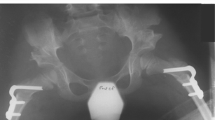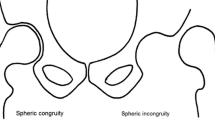Abstract
Developmental dysplasia of the hip (DDH) in cerebral palsy (CP) is very rare, and very little clinical data is available. We have analysed the results of open reduction of the hip (Howorth), acetabuloplasty (Salter, Pemberton), pelvic osteotomy (Chiari) and femoral osteotomy in the treatment of the DDH in CP patients. Radiographic assessment was based on the Severin grading classification system and measurements of migration percentage (MP) before and after surgery. Clinical results were analysed using the Ponsetti classification system in ambulatory patients. A total of 45 hips in 31 patients were treated surgically. The average age of the patients was 5.2 years (range: 2–16 years). The average follow-up was 9.6 years (range: 3–28 years). Analysis of the radiographic results according to Severin placed 35 hips (77.8%) in groups 1 and 2 and ten hips (22.2%) in groups 3 and higher. The average preoperative MP value was 78.7% and the average postoperative MP was 15.2%. Redislocation occurred in three hips. Clinical results were disappointing: based on Ponsetti assessment 14 hips (36.8%) were classified in the first three groups and 24 hips (63.2%) in the last three groups. This analysis suggests that these surgical procedures could be applied in treating DDH in CP.
Résumé
La dysplasie de hanche chez les patients présentant une infirmité motrice d’origine (IMOC) cérébrale est rare. Nous avons analysé les résultats de la réduction sanglante de hanche (Horworth), l’acétabuloplastie (Salter, Pemberton), l’ostéotomie pelvienne (Chiari) et l’ostéotomie fémorale dans le traitement de la dysplasie de hanche chez l’IMOC. Ces résultats ont été évalués selon la classification de Séverin, avec la mesure du pourcentage de migration avant et après traitement. Les résultats cliniques ont été évalués selon la classification de Ponsetti chez les patients ayant conservé la marche 45 hanches. 31 patients ont été analysés, l’âge moyen des patients est de 5,2 ans, le recul moyen a été de 9.6 ans (3 à 28). L’analyse des radiographies selon Séverin montre que 35 hanches (77.8%) sont classées dans le groupe 1 et 2, 10 hanches (22.2%) sont classées dans le groupe 3 et plus. Le pourcentage de migration pré-op est de 78.7% et 15.2% en post-op. Une reluxation est survenue dans trois hanches. Les résultats n’ont pas été satisfaisants. Selon Ponsetti 14 hanches (36.8%) ont été classées dans les trois premiers groupes et 24 hanches (63.2%) ont été classées dans les trois derniers groupes. Cette analyse nous permet de penser que ces traitements chirurgicaux peuvent être appliqués lors d’une luxation congénitale de hanche chez l’infirme d’origine cérébrale (IMOC).

Similar content being viewed by others
References
Barrie J, Galasco C (1966) Surgery for unstable hips in cerebral palsy. J Pediatr Orthop 5:225–331
Beals R (1969) Developmental changes in the femur and acetabulum in spastic paraplegia and diplegia. Dev Med Child Neurol 11:303–313
Bleck E (1987) Orthopaedic management in cerebral palsy. Blackwell/JB Lippincott, Oxford/Philadelphia
Chiari K (1974) Medial displacement osteotomy of the pelvis. Clin Orthop 98:55–71
Cooke P, Cole W, Carey R (1989) Dislocation of the hip in cerebral palsy. J Bone Joint Surg Br 71:441–446
Cooperman D, Bartucci E, Dietrick E, Miller E (1987) Hip dislocation in spastic cerebral palsy: long-term consequences. J Pediatr Orthop 7:268–276
Gamble J, Rinsky L, Bleck E (1990) Established hip dislocation in children with cerebral palsy. Clin Orthop 253:90–99
Griffiths G, Evans K, Roberts G, Loyd K (1977) The radiology of the hip joints and pelvis in cerebral palsy. Clin Radiol 28:187–193
Hilgenreiner H (1952) Zur Frühdiagnose und Frühbehandlungder angeborenen Hüftgelenkverrenkung. Med Klin 21:1385–1399
Howorth M (1952) Congenital dislocation of the hip. Technic of open reduction. Ann Surg 135:508–519
Kalen V, Bleck E (1985) Prevention of spastic paralytic dislocation of the hip. Dev Med Child Neurol 27:17–24
Kamath S, Bennet G (2005) Re-dislocation following open reduction for developmental dysplasia of the hip. Int Orthop 29:191–194
Lance M (1925) Constitution d’une butée ostéoplastique dans les luxations congénitales de la hanche. Presse Med 33:945–962
Onimus M, Manzone P, Calnizac J, Laurain J, Lebarbier P (1992) Le traitment chirurgical des luxations et subluxations de hanche chez l’IMC par osteotomie fémorale et pelvienne. Rev Chir Orthop 78:74–81
Pavlik A (1957) Die funktionelle Behandlungsmethode mittels Reimenbugel als Prinzip der Konservativen Therapie bei angebozanen Hüftgelenksverrenkungen der Sanglinge. Z Orthop 89:341–346
Pemberton P (1965) Pericapsular osteotomy of the ilium for treatment of congenital subluxation and dislocation of the hip. J Bone Joint Surg Am 47:65–86
Ponseti I (1944) Causes of failure in the treatment of congenital dislocation of the hip. J Bone Joint Surg 26:775–792
Reimers J (1980) The stability of the hip in children. A radiological study of the results of muscle surgery in cerebral palsy. Acta Orthop Scand [Suppl] 134:1–97
Salter R (1961) Innominate osteotomy in the treatment of congenital dislocation and subluxation of the hip. J Bone Joint Surg Br 43:518–539
Severin E (1941) Contribution to knowledge of congenital dislocation of hip joint: late results of closed reduction and arthrographic studies of recent cases. Acta Chir Scand 84[Suppl 63]:1–142
Sharrard W (1975) The hip in cerebral palsy. In: Samilson R (ed) Orthopaedic aspects of cerebral palsy. JB Lippincott, Philadelphia, pp 145–172
Suzuki R (1972) Congenital dislocation of the hip and cerebral palsy. Seikei Geka 23:282
Tachdjian M (1990) Pediatric orthopedics. WB Saunders, Philadelphia London Toronto Sydney Tokyo
Vidal J, Deguillaume P, Vidal M (1985) The anatomy of the displastic hip in cerebral palsy related to prognosis and treatment. Int Orthop 9:105–110
Ward T, Molly V, Grudziak J, Tümer Y, Christopher C, Fitch R (1997) Severin classification system for evaluation of the results of operative treatment of congenital dislocation of the hip. A study of intraobserver and interobserver reliability. J Bone Joint Surg Am 79:656–663
Author information
Authors and Affiliations
Corresponding author
Additional information
Each author certifies that this investigation was performed in accordance with the ethical standards laid down in the 1964 Declaration of Helsinki. All authors agree on the content and state that this article is original, that it has not been considered by another journal and that the material has not been previously published.
Rights and permissions
About this article
Cite this article
Gavrankapetanovic, I., Cobeljic, G., Bajin, Z. et al. Developmental dysplasia of the hip in cerebral palsy–surgical treatment. International Orthopaedics (SICO 31, 561–568 (2007). https://doi.org/10.1007/s00264-006-0224-6
Received:
Revised:
Accepted:
Published:
Issue Date:
DOI: https://doi.org/10.1007/s00264-006-0224-6




